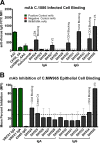Combined HIV-1 Envelope Systemic and Mucosal Immunization of Lactating Rhesus Monkeys Induces a Robust Immunoglobulin A Isotype B Cell Response in Breast Milk
- PMID: 26937027
- PMCID: PMC4859715
- DOI: 10.1128/JVI.00335-16
Combined HIV-1 Envelope Systemic and Mucosal Immunization of Lactating Rhesus Monkeys Induces a Robust Immunoglobulin A Isotype B Cell Response in Breast Milk
Abstract
Maternal vaccination to induce anti-HIV immune factors in breast milk is a potential intervention to prevent postnatal HIV-1 mother-to-child transmission (MTCT). We previously demonstrated that immunization of lactating rhesus monkeys with a modified vaccinia Ankara (MVA) prime/intramuscular (i.m.) protein boost regimen induced functional IgG responses in milk, while MVA prime/intranasal (i.n.) boost induced robust milk Env-specific IgA responses. Yet, recent studies have suggested that prevention of postnatal MTCT may require both Env-specific IgA and functional IgG responses in milk. Thus, to investigate whether both responses could be elicited by a combined systemic/mucosal immunization strategy, animals previously immunized with the MVA prime/i.n. boost regimen received an i.n./i.m. combined C.1086 gp120 boost. Remarkably, high-magnitude Env-specific IgA responses were observed in milk, surpassing those in plasma. Furthermore, 29% of vaccine-elicited Env-specific B cells isolated from breast milk were IgA isotype, in stark contrast to the overwhelming predominance of IgG isotype Env-specific B cells in breast milk of chronically HIV-infected women. A clonal relationship was identified between Env-specific blood and breast milk B cells, suggesting trafficking of that cell population between the two compartments. Furthermore, IgA and IgG monoclonal antibodies isolated from Env-specific breast milk B cells demonstrated diverse Env epitope specificities and multiple effector functions, including tier 1 neutralization, antibody-dependent cellular cytotoxicity (ADCC), infected cell binding, and inhibition of viral attachment to epithelial cells. Thus, maternal i.n./i.m. combined immunization is a novel strategy to enhance protective Env-specific IgA in milk, which is subsequently transferred to the infant via breastfeeding.
Importance: Efforts to increase the availability of antiretroviral therapy to pregnant and breastfeeding women in resource-limited areas have proven remarkably successful at reducing HIV vertical transmission rates. However, more than 200,000 children are infected annually due to failures in therapy implementation, monitoring, and adherence, nearly half by postnatal HIV exposure via maternal breast milk. Intriguingly, in the absence of antiretroviral therapy, only 10% of breastfed infants born to HIV-infected mothers acquire the virus, suggesting the existence of naturally protective immune factors in milk. Enhancement of these protective immune factors through maternal vaccination will be a critical strategy to reduce the global pediatric AIDS epidemic. We have previously demonstrated that a high magnitude of HIV Env-specific IgA in milk correlates with reduced risk of infant HIV acquisition. In this study, we describe a novel HIV vaccine regimen that induces potent IgA responses in milk and therefore could potentially protect against breast milk HIV MTCT.
Copyright © 2016, American Society for Microbiology. All Rights Reserved.
Figures








Similar articles
-
Impact of Poxvirus Vector Priming, Protein Coadministration, and Vaccine Intervals on HIV gp120 Vaccine-Elicited Antibody Magnitude and Function in Infant Macaques.Clin Vaccine Immunol. 2017 Oct 5;24(10):e00231-17. doi: 10.1128/CVI.00231-17. Print 2017 Oct. Clin Vaccine Immunol. 2017. PMID: 28814388 Free PMC article.
-
Mucosal immunization of lactating female rhesus monkeys with a transmitted/founder HIV-1 envelope induces strong Env-specific IgA antibody responses in breast milk.J Virol. 2013 Jun;87(12):6986-99. doi: 10.1128/JVI.00528-13. Epub 2013 Apr 17. J Virol. 2013. PMID: 23596289 Free PMC article.
-
A Trimeric HIV-1 Envelope gp120 Immunogen Induces Potent and Broad Anti-V1V2 Loop Antibodies against HIV-1 in Rabbits and Rhesus Macaques.J Virol. 2018 Feb 12;92(5):e01796-17. doi: 10.1128/JVI.01796-17. Print 2018 Mar 1. J Virol. 2018. PMID: 29237847 Free PMC article.
-
Nonneutralizing functional antibodies: a new "old" paradigm for HIV vaccines.Clin Vaccine Immunol. 2014 Aug;21(8):1023-36. doi: 10.1128/CVI.00230-14. Epub 2014 Jun 11. Clin Vaccine Immunol. 2014. PMID: 24920599 Free PMC article. Review.
-
Protection of neonatal macaques against experimental SHIV infection by human neutralizing monoclonal antibodies.Transfus Clin Biol. 2001 Aug;8(4):350-8. doi: 10.1016/s1246-7820(01)00187-2. Transfus Clin Biol. 2001. PMID: 11642027 Review.
Cited by
-
Impact of Poxvirus Vector Priming, Protein Coadministration, and Vaccine Intervals on HIV gp120 Vaccine-Elicited Antibody Magnitude and Function in Infant Macaques.Clin Vaccine Immunol. 2017 Oct 5;24(10):e00231-17. doi: 10.1128/CVI.00231-17. Print 2017 Oct. Clin Vaccine Immunol. 2017. PMID: 28814388 Free PMC article.
-
Phagocytosis of a Model Human Immunodeficiency Virus Target by Human Breast Milk Leukocytes Is Predominantly Granulocyte-Driven When Elicited by Specific Antibody.Breastfeed Med. 2019 Apr;14(3):185-192. doi: 10.1089/bfm.2018.0232. Epub 2019 Mar 13. Breastfeed Med. 2019. PMID: 30864817 Free PMC article.
-
Impact of IgG Isotype on the Induction of Antibody-Dependent Cellular Phagocytosis of HIV by Human Milk Leukocytes.Front Immunol. 2022 May 3;13:831767. doi: 10.3389/fimmu.2022.831767. eCollection 2022. Front Immunol. 2022. PMID: 35592337 Free PMC article.
-
Maternal Humoral Immune Responses Do Not Predict Postnatal HIV-1 Transmission Risk in Antiretroviral-Treated Mothers from the IMPAACT PROMISE Study.mSphere. 2019 Oct 23;4(5):e00716-19. doi: 10.1128/mSphere.00716-19. mSphere. 2019. PMID: 31645430 Free PMC article. Clinical Trial.
-
Bridging Vaccine-Induced HIV-1 Neutralizing and Effector Antibody Responses in Rabbit and Rhesus Macaque Animal Models.J Virol. 2019 May 1;93(10):e02119-18. doi: 10.1128/JVI.02119-18. Print 2019 May 15. J Virol. 2019. PMID: 30842326 Free PMC article.
References
-
- Shapiro RL, Hughes MD, Ogwu A, Kitch D, Lockman S, Moffat C, Makhema J, Moyo S, Thior I, McIntosh K, van Widenfelt E, Leidner J, Powis K, Asmelash A, Tumbare E, Zwerski S, Sharma U, Handelsman E, Mburu K, Jayeoba O, Moko E, Souda S, Lubega E, Akhtar M, Wester C, Tuomola R, Snowden W, Martinez-Tristani M, Mazhani L, Essex M. 2010. Antiretroviral regimens in pregnancy and breast-feeding in Botswana. N Engl J Med 362:2282–2294. doi:10.1056/NEJMoa0907736. - DOI - PMC - PubMed
-
- WHO, UNICEF, UNAIDS. 2014. Global HIV/AIDS response. Epidemic update and health sector progress towards universal access. Progress report 2014. World Health Organization, Geneva, Switzerland.
-
- Munoz FM, Englund JA. 2000. A step ahead. Infant protection through maternal immunzation. Pediatr Clin North Am 47:449–463. - PubMed
Publication types
MeSH terms
Substances
Grants and funding
LinkOut - more resources
Full Text Sources
Other Literature Sources
Miscellaneous

